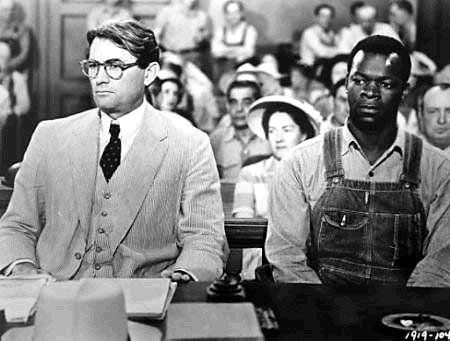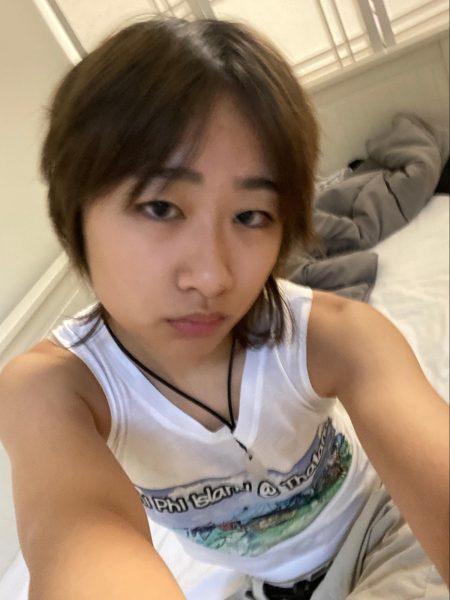Confronting Slurs in the Classroom

Still from the film adaptation of To Kill a Mockingbird—one of the most renowned classics of American literature.
May 24, 2023
In fifth grade, while teaching a lesson about Martin Luther King Jr., my (white) teacher recited a part of his famous “I Have a Dream” speech, wherein she said the n-word; she followed it with a warning to never use the word outside the classroom, and further explanation behind its meaning was given.
In eighth grade, I, along with the rest of my English class, was confronted with the same problem in our assigned reading of A Raisin in the Sun—the repeated use of the n-word throughout the play. Our teacher, obviously uncomfortable with the topic, brushed over it, simply stating that it would be up to the individual student to decide whether or not they’d want to say it. Most ended up opting to replace it with a less demeaning word, like “man” or “person,” but not all. And, in my (mostly independent) reading of To Kill a Mockingbird in tenth grade, there was no mention by the teacher at all of the word.
Tip-toeing around hateful language in literature is a common pattern for schools across the board, and the issue of the n-word in particular has taken America by storm in recent years. Stories of professors getting fired and students holding protests over the usage of this word have spread like wildfire. Although less quiet at South High, some English teachers here maintain a policy of allowing students to decide whether or not they can say it while reading a passage aloud.
Time and time again, people have brought up free speech in the classroom in an attempt to diminish this issue. Many cite our First Amendment right to free speech as justification—after all, wasn’t America built on the premise of granting its citizens basic autonomy? There’s a certain hypersensitivity that surrounds the restriction of language, especially in a setting where students are meant to learn impartially. A withstanding argument is that, when reading classic literature, one must stay true to the source material.
However, the n-word entails meaning and history that goes beyond “just a word.” When the first shipload of slaves were brought to colonial America, it was used to describe them—originally not in an intentionally derogatory way, but nonetheless dehumanizing. The practice continued as slavery and discrimination became increasingly universal; a total of around 12 million Africans were transported through the Middle Passage, and the population continued to grow within America over the centuries.
Furthermore, segregation is ingrained into America’s history, reaching far beyond the abolition of slavery. The Equal Justice Initiative has recorded a total of nearly 4,000 black people lynched in 1887-1950 (1887 being the second year after slavery was abolished). Even more alarming is the fact that the violence hasn’t nearly seen a substantial enough decrease over the years. The entire nation was swept up in the surge of outrage and protest after the murder of George Floyd in 2020—a product of decades-long stagnation in the pursuit of racial justice. For many, these events were an eye-opener for the systemic racism that black Americans face, especially in the context of police brutality; 27% of fatal victims of police brutality in the U.S. are black, even though they account for only 13% of the total population.
And, today, the n-word continues to be used to express hatred and emphasize the otherness of black people as it did centuries ago. Of a majority-black sample of undergraduate students, 76% thought that saying the n-word was unacceptable for nonblack people, no matter what the context may be. It isn’t a radical idea that the n-word contains a violent history that extends into today’s world; giving nonblack students and teachers a safe space to say it will only continue to perpetuate the violence that the millions of black people forcefully brought to America had to endure. The word encapsulates the dehumanization of black Americans, and we are responsible for being implicit in the hatred it perpetuates.
For such a seemingly omnipresent problem, the solution is quite simple: English teachers can start by having conversations dedicated to the use of hateful language in literature. After all, it’s important to understand the context in which stories are written—the location, time period, and author’s background are all factors that contribute to our understanding of the nuances of a book’s meaning and intent. Attempts to gloss over the word would be ineffective in the long run, as it would only foster more confusion and ignorance. High schoolers have the capacity to talk about nuanced subjects; teachers even more so.
“I think this type of language needs to be contextualized for students. We cannot just let slurs within the literature pass by unaddressed,” said Dr. Scott Honig, a longtime English teacher whose courses encompass topics like creative writing, public speaking, graphic novels, and literature. “It’s the proverbial elephant in the room.”
“This year I taught To Kill a Mockingbird, which has several uses of the n-word in it,” he continued. “The racism featured in the Depression-era South just isn’t authentically represented without that word. So that has to be a conversation with my students so they understand why this word appears and how we are going to treat it.”
The second, exceedingly simple part of the solution is to not repeat any derogatory words that one might encounter in a book. It takes minimal effort to do so, and is an easy first step to dismantling the centuries-long oppression ingrained into our school systems. Being prevented from saying a few out of the tens/hundreds of thousands of words in a book isn’t an infringement on anyone’s rights, especially when such words generate implied hatred against a minority group.
By omitting a few words from our vocabulary and spending a few minutes to discuss the sensitivities surrounding such words, we can spread awareness about the history of prejudice, while actively working to undo its long-term consequences. There is extremely little standing in the way of beginning concrete, positive change in not just our school, but those across the nation and world. As students and teachers, we can ultimately make the conscious decision to take a step in the right direction for social justice and a safer learning environment for all.





